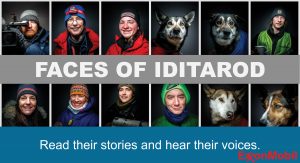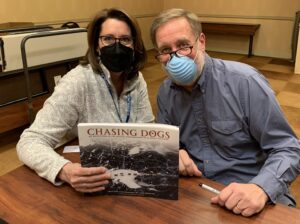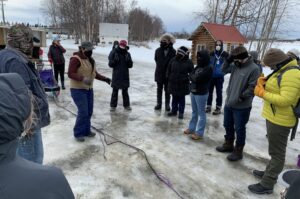It’s go time! Fourth street is transformed as the iconic Iditarod Sled Dog Race banner is ready to welcome mushers and dogs to the 50th Iditarod Sled Dog Race!
For 50 years the Iditarod Sled Dog Race has been a champion of excellence in dog welfare, health and nutrition, and a model for volunteerism and preservation of history. Volunteers are the backbone of the Iditarod and are recognized and celebrated as the race is about to kick off!
As a teacher, we strive to build a positive culture and climate in our classrooms so learning can be engaging, focused and meet the needs of all of our students. A classroom’s positive sense of community also comes from everyone working together and having daily or weekly jobs to keep the classroom running smoothly. The volunteer structures of the Iditarod Race are similar to the community building work we do in our classrooms. Without the work of the volunteers, there would be no race. Let’s recognize a few of the behind the scenes structures run mostly by volunteers that are the backbone of making this inspirational and aspirational race happen each year.
Iditarod Race Marshal
Mark Nordman has been the Iditarod Race Marshal since 1983. He approaches everyday with passion and a thankfulness for having a job he absolutely loves. Mark shared that the making of the Iditarod Race is logistically the most challenging race in the world to create. He works with volunteers in villages who prepare for the race to come through their communities. He also works with trail-breakers, trail-sweeps and makes sure judges and veterinarians are at checkpoints when the mushers come through. He also is in charge of 15,300 trail marker sticks with reflective tape and making sure trail conditions are suitable for dogs and mushers.
Teachers: Building bridges out of sticks or ice in the Dalzell Gorge is one of Mark’s teams responsibilities. Have your students look at the Dalzell Gorge (use Google Earth) and create a smoother route over a stream or up a rough part of the trail for the sled dog teams to travel. Only use materials native in that area.
Iditarod Air Force
Twenty nine pilots using their personal planes make up the Iditarod Air Force. They average 1,000-1,500 hours of flight time during an Iditarod Race. They only fly during the day as they need to land when it is light out since so many of their landing strips have no lights and are in remote parts of Alaska. Landing strips are cleared before and during the race and they have even used frozen rivers as a place to set the planes down. They fly race judges, veterinarians and the Teacher on the Trail to different checkpoints, and bring food in and take garbage out of checkpoints. When dogs are returned during the race, the airplanes can each carry 8-11 dogs, and the favorite thing a sled dog does during their plane ride is sleep. The pilots approach volunteering for the Iditarod with passion as they enjoy supporting this amazing race and reconnecting with volunteers at checkpoints and villages who have become life-long “Iditarod time” friends.
Teachers: Research what it takes to be a pilot, plane mechanic or runway creator in wilderness areas. What expertise is needed to be an Iditarod Air Force pilot.
Trail Communications
Can you plan an event where you know where everyone is all the time? If you can, then you would be great volunteering in Trail Communications, or Comms. Anyone who goes out onto the Iditarod Trail is tracked and monitored. Every vet, volunteer, checkpoint worker, trail support person, judge, musher and dogs are tracked through Comms. Comms also work with pilots to help get people to new destinations quickly and safely. A challenging part of Comms is having reliable technology throughout the entire race.
Teachers: Have students create a Comms dialog as if they were getting information from a checkpoint. Who might be at the checkpoint, who might be leaving the checkpoint and why and which mushers and dogs might be at the checkpoint. Use the Faces of the Iditarod, located on the Iditarod website, to learn more about the volunteers (including dogs) as some of your subjects for this piece of realistic fiction writing.
Jeff Schultz Official Iditarod Photographer
The Iditarod Race experience is captured and brought to us as if we were sitting on the side of the trail or directly traveling on the trail because of Jeff Schultz. Jeff has photographed the Iditarod Race for 43 years. He has buried cameras in the snow for dog teams to run over to catch an action angle of a dog team, and he has waited for several hours in a remote place for a mushing team to come by to get that extraordinary photo with dramatic shadows and a pristine background of glistening snow. His favorite Iditarod photos are of musher and dog, snuggling and showing tenderness together with frost on their faces and the busyness of the race temporarily halted while the musher provides a well deserved paw massage. Jeff also produces Faces of the Iditarod, located on the Iditarod website, to showcase the extraordinary volunteers and workers that make this race happen.
Teachers: Go on an observation walk outside with your students. Take an iPad/Chromebook/Phones or a paper and pencil and have students notice their surroundings by taking photos or drawings. Use that work for a writing prompt. (Idea for prompt: Look for emotion or beauty in nature)
Dog Handling
Another hero of Iditarod volunteers are the Dog Handlers. Helping a musher and their dogs get safely to the starting line is the role of these volunteers. Jogging behind a sled dog, holding the gangline taut and staying away from the dog’s feet is the job of a dog handler. So kudos to all those volunteers who get to wish each musher and sled dog a safe trip before they explode from the shoot on their way to Nome.
Teachers: What are other jobs people can do that would involve working with dogs. Consider checking out The Seeing Eye organization and learn more about service dogs.
Teachers
Finally, teachers teaching Iditarod themes and lessons in their classrooms are valued Iditarod volunteers too! The Teacher on the Trail program is run by teacher volunteers who see the excitement in students’ eyes whenever they do “anything Iditarod” in their classrooms. Thanks for spreading the word about the Iditarod to a new generation of students who might one day journey north to Alaska and ride their own dog team down the Iditarod Trail, just like so many mushers before them.
Try one of these ideas as your class enjoys following the Iditarod Sled Dog Race this next week!









